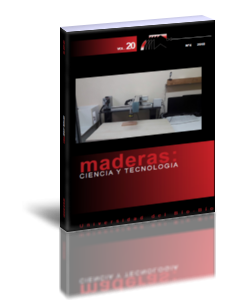Using artificial neural networks in estimating wood resistance
Keywords:
Artificial intelligence, Eucalyptus urograndis, hardness, mechanical properties, non-destructive testingAbstract
The purpose of this research was to evaluate the potential of Artificial Neural Networks in estimating the properties of wood resistance. In order to do so, a hybrid of eucalyptus (Eucalyptus urograndis) planted in the Northern Region of the State of Mato Grosso was selected and ten trees were collected. Then, four samples of each tree were removed, totaling 40 samples, which were later subjected to non-destructive testing of apparent density, ultrasonic wave propagation velocity, dynamic modulus of elasticity obtained by ultrasound, and Janka hardness. These properties were used as estimators of resistance and compressive strength parallel to fibers, and hardness. Multilayer Perceptron networks were also employed, training 100 of them for each of the evaluated parameters. The obtained results indicated that the use of Artificial Neural Networks is an efficient tool for predicting wood resistance.
Downloads
References
Associação Brasileira de Normas Técnicas – ABNT. 2001. NBR 7190: Projetos de estruturas de madeira. Rio de Janeiro.
Bassa, A. G. M. C.; Silva Júnior, F. G.; Sacon, V. M. 2007. Misturas de madeira de Eucalyptus gradis x Eucalyptus urophylla e Pinus taeda para produção de celulose kraft através do Processo Lo-Solids. Scientia Forestalis 75(4): 19-30.
Bardak S.; Tiryaki S.; Nemli, G.; Aydın A. 2016. Investigation and neural network prediction of wood bonding quality based on pressing conditions. International Journal of Adhesion and Adhesives 68(5): 115–123.
Binoti, M. L. M. S. 2013. Aplicação de redes neurais artificiais para estimação da altura de povoamentos equiâneos de eucalipto. Revista Árvore 37(4): 639-645.
Binoti, M. L. M. S.; Leite, H. G.; Binoti, D. H. B.; Gleriani, J. M. 2015. Prognose em nível de povoamento de clones de eucalipto empregando redes neurais artificiais. Cerne 21(1): 97-105.
Castro, R. V. O.; Soares, C. P. B.; Leite, H. G.; Souza, A. L.; Nogueira, G. S.; Martins, F. B. 2013. Individual growth model for Eucalyptus Stands in Brazil using artificial neural network. ISRN Forestry, Article ID 196832.
Chen, W. C.; Tseng, L. Y.; Wu, C. S. 2014. A unified evolutionary training scheme for single and ensemble of feedforward neural network. Neurocomputing 143(C): 347-361.
Comisión Panamericana de Normas Técnicas – COPANT. 1972. COPANT 458: Seleção das amostras.
Cybenko, G. V. 1989. Approximation by superpositions of a sigmoidal function. Mathematics of Control, Signals and System 2(4): 303-314.
Draper, N. R.; Smith, H. 1981. Applied regression analysis. New York: Jonh Willey & Sons 407 p.
Egrioglu, E.; Yolcu, U.; Aladag, C.H.; Bas, E. 2014. Recurrent multiplicative neuron model artificial neural network for non-linear time series forecasting. Procedia - Social and Behavioral Sciences 109(8): 1094-1100.
Esquerre, K. P. O.; Mori, M.; Bruns, R. E. 2002. Simulation of an industrial wastewater treatment plant using artificial neural networks and principal components analysis. Brazilian Journal of Chemical Engineering 19(4): 365-370.
Goyal, S. 2013. Artificial neural networks in vegetables: a comprehensive review. Scientific Journal of Crop Science 2(7): 75-94.
Haykin, S. 2001. Redes neurais: princípios e prática. Porto Alegre: Bookman, 900p.
Heaton, J. 2011. Programming Neural Networks with Encog3 in Java. 2ed. St. Louis: Heaton Research Incorporated, 240p.
Leite, H. G.; Silva, M. L. M.; Binoti, D. H. B.; Fardin, L.; Takizawa, F. H. 2011. Estimation of inside-bark diameter and heartwood diameter for Tectona grandis Linn. trees using artificial neural networks. European Journal of Forest Research 130(2): 263-269.
Kuvendziev A. S.; Lisichkova K.; Zekovic, Z.; Marinkovski, M. 2014. Artificial neural network modelling of supercritical fluid CO2 extraction of polyunsaturated fatty acids from common carp (Cyprinus carpio L.) viscera. J. Supercrit Fluids 92(6):242-248.
Mehtätalo, L.; Maltamo, M.; Kangas, A. 2006. The use of quantile trees in the prediction of the diameter distribution of a stand. Silva Fennica 40(3):501-516.
Miguel, E. P.; Rezende, A. V.; Leal, F. A.; Matricardi, E. A.; Vale, A. T.; Pereira, R. S. 2015. Redes neurais artificiais para a modelagem do volume de madeira e biomassa do cerradão com dados de satélite. Pesquisa Agropecuária Brasileira 50(9): 829-839.
Miguel, E. P.; Mota, F. C. M.; Teo, S. J.; Nascimento, R. G. M.; Leal, F.A.; Pereira, R. S.; Rezende, A. V. 2016. Artificial intelligence tools in predicting the volume of trees within a forest stand. African Journal of Agricultural Research 11(21): 1914-1923.
Melo, R. R.; Miguel, E. P. 2016. Use of artificial neural networks in predicting particleboard quality parameters. Revista Árvore 40(5): 949-958.
Okan, O. T.; Deniz, I.; Tiryaki, S. 2015. Application of artificial neural networks for predicting tensile index and brightness in bleaching pulp. Maderas-Cienc Tecnol 17(3): 571-584.
Shiblee, M. D.; Chandra, B.; Kalra, P. K. 2010. Learning of geometric mean neuron model using resilient propagation algorithm. Expert Systems with Applications 37(12): 7449-7455.
Silva, I. N.; Spatti, D. H.; Flauzino, R. A. 2010. Redes Neurais Artificiais para engenharia e ciências aplicadas. São Paulo: Artliber. 397p.
Stangerlin, D. M.; Calegari, L.; Santini, E. J.; Domingues, J. M. X.; Gatto, D. A.; Melo, R. R. 2008. Determinação do módulo de elasticidade em madeiras por meio de métodos destrutivo e não destrutivo. Revista Brasileira de Ciências Agrárias 3(2): 145-150.
Tiryaki, S.; Aydın, A. 2014. An artificial neural network model for predicting compression strength of heat treated woods and comparison with a multiple linear regression model. Construction and Building Materials 62(13): 102-108.
Tiryaki, S.; Hamzacebi, C. 2014. Predicting modulus of rupture (MOR) and modulus of elasticity (MOE) of heat treated woods by artificial neural networks. Measurement 49(3): 266–274.
Tiryaki, S.; Bardak, S.; Aydın, A.; Nemli, G. 2016. Analysıs of volumetrıc swellıng and shrınkage of heat treated woods: experımental and artıfıcıal neural network modelıng approach. Maderas-Cienc Tecnol 18(3): 477–492.
Zucchini, W. 2000. An introduction to model selection. Journal of Mathematical Psychology 44(1): 41-61.

































